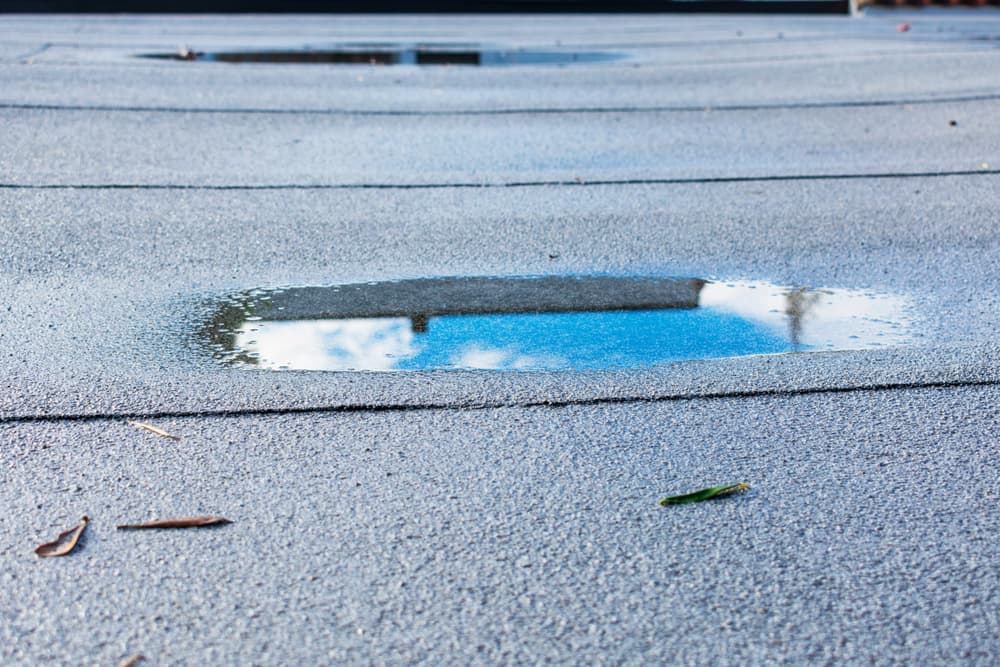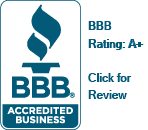
If your roof appears to be dipping or sagging, this could highlight a problem with its structural integrity. However, in some cases, it could also be minor and require a simple fix. But when it comes to any potential problems with the roof, it’s best to have a professional roofer look at it to ensure it’s safe. It can be dangerous if you’re not experienced, untrained, or comfortable with heights. If you’re wondering how to fix a sagging, flat roof, here’s how the process goes.
Contents
Determine the Cause
First and foremost, identifying the source of the problem that’s causing sunken areas on the roof is important. In some cases, it could be caused by moisture damage, weakened sheathing, rotting joints, or sagging insulation. Flat roofs are typically more susceptible to water damage due to their design. If water pools on the roof with nowhere to go, it can eventually weaken the structure and lead to rot and potential low dips. A complete teardown and roof replacement would be ideal, depending on how severe the water damage is. However, let’s try and mitigate a teardown situation by learning how to fix a sagging flat roof through a variety of different methods.
The Most Common Reasons for Sagging Roofs
- Water damage
- Weakened Sheathing
- Insulation that sags
- Age of the roof
- The excess weight caused by snow and ice
- Improper design and construction
- Poor-quality roofing materials
- Sunk or shifted foundation
Materials that Can Raise Sunken Areas
When sunken areas develop, and it’s not due to structural issues, they can be raised using a range of materials, depending on your roof-specific design. Here are the materials that can be used:
Sheet Fillers
When learning to fix a sagging flat roof, it’s vital to know about the materials the home is made from and their age. Many older homes with older roofs were constructed using pieces of asphalt felt paper, which were combined with tar to create flat roof designs back in the day. With felt roofs, sunken areas can be filled using this same method, requiring a few extra layers of felt and tar to prop up those low dips. There are a few different options today, but it’s best to stick with something that’s on par with your existing roof material.
Asphalt-infused, tar-saturated, or polyester felt are the main options to choose from today. Whichever is used, always adhere to the manufacturer’s instructions carefully. Then place gravel, cap sheet, or asphalt over the top of the felt once it’s applied. For more modern, flat roofs that use rubber, you can prop up sagging areas by using the same rubber material and then just cut it based on where it needs to be placed. It’ll need to be bonded with bitumen after applying the rubber. This is a great example of how to fix a sagging flat roof.
Liquid Patching Materials
Alternatively, you could use a liquid filler such as roof patch putty to fix a sagging flat roof. A general epoxy concrete filler, followed by mastic sealant, can also work. For gravel roofs, make sure to brush away the gravel so you can apply the material directly on the roof.
Asphalt Fills
Asphalt fills can be applied, along with a liquid asphalt roof coating. This is suitable for roofs made from asphalt, metal, or concrete. This will provide a waterproof coating to protect the structure from future moisture damage. An excellent approach to fixing a sagging flat roof.
How to Prevent a Flat Roof from Sagging
A sagging roof can signal issues with structural integrity, but with regular maintenance and proactive measures, property owners can often prevent significant problems. Here’s how you can help prevent a flat roof from sagging, even without roofing experience:
Regular Maintenance and Inspections
- Visual Inspections: Periodically check your roof from the ground using binoculars. Look for visible sagging, missing or damaged shingles, or uneven areas. Catching these issues early can prevent minor problems from becoming major repairs.
- Check the Attic: Inspect the attic for any signs of water damage, such as stains on the wood or any light coming through the roof that shouldn’t be there. Early detection of leaks or weak spots can save you from extensive repairs down the line.
- Clear Debris: Keep the roof free from debris like leaves, branches, and other materials. This can be done with a roof rake or by hiring someone to clean the roof safely. Debris can trap moisture, leading to rot and other damage.
- Gutter Maintenance: Ensure gutters are clean and clear of leaves and debris. Clogged gutters can cause water to back up and seep under the roof, potentially leading to damage. Proper drainage is essential to prevent water-related issues.
Preventive Measures
- Snow Removal: If your building is located in an area with heavy snowfall, use a roof rake to gently remove excess snow from the roof when possible. This prevents the added weight from causing sagging. Heavy snow can exert significant pressure on your roof structure.
- Trim Trees: Keep trees trimmed away from the roof to prevent branches from falling and to reduce the accumulation of debris. Overhanging branches can damage shingles and contribute to debris build-up.
Simple Repairs
- Seal Small Leaks: If you notice small leaks or cracks, use roofing sealant to patch them up. This can prevent water from causing further damage to the roof structure. Addressing leaks promptly can prevent them from expanding and causing more extensive damage.
- Pest Control: Regularly check for signs of pests like termites or carpenter ants in the attic. If you find any, contact a pest control professional immediately. Pests can cause significant structural damage if not controlled.
Reinforcement and Professional Help
- Support Beams: If you notice minor sagging, you can install temporary support beams in the attic. This may help distribute the load until a professional can inspect and fix the problem. Reinforcing weak areas can prevent further deterioration.
- Professional Inspections: Schedule a professional roofing inspection every few years, or after major storms, to catch potential issues early. Professionals can spot problems that are easy to miss. Regular inspections ensure your roof remains in good condition.
- Hire for Major Repairs: For significant issues like noticeable sagging, structural damage, or extensive leaks, hire a professional roofer to handle the repairs. Attempting to fix major issues without experience can be dangerous. Professionals have the skills and equipment to safely and effectively repair serious problems.
Monitoring and Safety
- Stay Safe: If you need to inspect or clean the roof, always prioritize safety. Use a stable ladder, and consider using safety gear like a harness. If you are unsure or uncomfortable, hire a professional. Safety should always come first.
- Keep Records: Maintain a record of inspections, maintenance, and any repairs done. This can help track the roof’s condition and provide valuable information if you need professional help. Detailed records can also be helpful if you need to make an insurance claim or decide to sell.
The Bottom Line
Maintaining your flat roof and addressing minor issues as soon as possible can help prevent sagging and ensure its longevity. Roofs are constantly exposed to weather elements, making them susceptible to damage, especially older flat roofs. Regular maintenance, minor repairs, and knowing when to call a professional are key to keeping your roof in good shape.
If you notice significant sagging or other major issues, don’t risk injuring yourself. Reach out to our team at Roofmaster. We can identify the problem and perform necessary repairs to ensure your roof is safe and protected.










